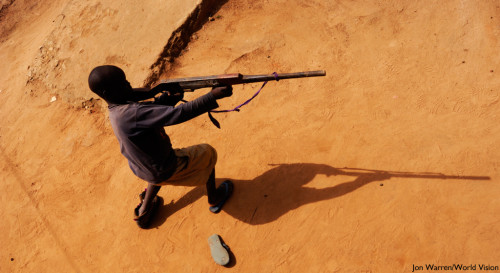10 Facts about Child Soldiers…

Boys play with a wooden gun used in re-enactment dramas, which can be part of rehabilitation therapy sessions. Courtesy of World Vision
- How do you define a ‘child soldier’? The UN Convention on the Rights of a Child (1990) defined childhood as under 18 years of age. In 1997 an International conference in Cape Town adopted the definition, “any person under 18 years of age who is part of any kind of regular or irregular armed force or armed group in any capacity…” A key 2nd Conference in Paris 2007[1] concluded with a definition of, “any person below 18 years of age who is or who has been recruited or used by an armed force or armed group in any capacity, including but not limited to children, boys and girls used as fighters, cooks, porters, messengers, spies or for sexual purposes. It does not only refer to a child who is taking or has taken a direct part in hostilities.”
- The Child Soldiers Global Report 2001 of the International Coalition to Stop the Use of Child Soldiers estimated there are 300,000-plus child soldiers at any point in time[2]. Forty percent of those are thought to be girls[3]. Most are aged between 13-17 years, but they are accounts of children as young as 7.
- Why do they join how do they become child soldiers? Many children are forcible recruited and brain washed. Children are cheap requiring less pay and food, available in times of conflict when schools, homes and other places of infrastructure are destroyed, convenient as they are teachable and vulnerable to both political persuasion and violence – particularly when their primary care giver is threatened, violated or killed.
- We often view this as a human rights issue, but is it a peace issue? War intensifies poverty and poverty reduces or destroys the power of choice and increases vulnerability to extreme political agenda. Quickly the gap between an active civilian life and one of organized violence is bridged.
- How do children evolve from being normal, moral children to brutal soldiers able to carry out atrocities? The training varies across geographical areas, but common threads include a baptism of fire approach into a culture of violence, fueling a culture of control and obedience that is often rewarded by greater access to food or health care for example. Isolation increases the culture of fear amongst the children and unquestioning obedience. Following orders is rewarded by the protection of ones life. An encouragement to devalue and dehumanize the enemy creates the ability for commanders to lead the children in to a ‘new moral space[4]’ where the rules are totally different and following them is the only thing that guarantees their protection. Over time most children adapt to their new set of values and often when this is paired with a political awakening to explain their poverty this becomes a compelling motivation for committing violence.
- Geographically the issue is global. All states should have an interest in the protection of children from recruitment as child soldiers. From Angola, to the DRC, to Colombia, to Afghanistan, to Indonesia, to Nepal, to Russia, to Iran and to the Sudan to name but a few – every continent has at some point been affected.
- The implementation of national Disarmament, Demobilization, and Reintegration (DDR) programs following the end of armed conflict involves soldiers turning in their weapons, the formal disbanding of military groups including the surrender of uniforms and the release of combatants and finally the longer term process of reintegration to civilian life, finding viable roles for former soldiers and places of education. These programs are as necessary for children as adult soldiers. More tailor-made programs are require and a greater sharing of knowledge of effective programs would radically increase their success.
- Attacking poverty is critically important. Lack of educational and vocational opportunity is a major contributory factor for children remaining with their role and identity as a soldier. Continuing as a child soldier provides them with an infrastructure within which to be fed and survive.
- What can be done to protect vulnerable children? Prevention and protection must be sought and struggled for. Global campaigns to strengthen child protection must be pursued. Research that identifies effective DDR programs must be conducted. Strengthening the International Criminal Court and its ability to prosecute child recruiters; building into international peace agreements provision for children’s DDRs and preventing further recruitment and penalties administered by the UN Security Council on countries that trade weapons with countries that exploit children as soldiers are also critical to solving this problem.
- How can we increase the effectiveness of intervention programs? We can do a better job of gathering success stories of prevention and rehabilitation and disseminating them. There are some incredible stories of success from which we can take courage and continue to move forward with hope and purpose.
Footnotes:
[1] Co-hosted by UNICEF and the French Government.
[2] Child Soldiers, From Violence to Protection, Michael Wessells, Harvard Press. Page 9.
[3] Save The Children UK 2005.
[4] Child Soldiers, From Violence to Protection, Michael Wessells, Harvard Press. Page 65.
This list was compiled by CLC Contributing Writer Deborah Andrews.

